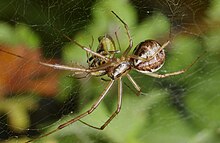Linyphia triangularis
| Linyphia triangularis | |
|---|---|

| |
| Scientific classification | |
| Domain: | Eukaryota |
| Kingdom: | Animalia |
| Phylum: | Arthropoda |
| Subphylum: | Chelicerata |
| Class: | Arachnida |
| Order: | Araneae |
| Infraorder: | Araneomorphae |
| Family: | Linyphiidae |
| Genus: | Linyphia |
| Species: | L. triangularis
|
| Binomial name | |
| Linyphia triangularis | |
Linyphia triangularis is a European species of spider in the family Linyphiidae first described by Carl Alexander Clerck in his 1758 Svenska Spindlar.
Description
Linyphia triangularis grows up to 6 millimetres (0.24 in) long. The carapace is pale brown with darker markings along the edges and down the centre line; the opisthosoma has a coarsely serrate brown band against a white background, with further brown markings along the sides. The legs are greyish brown, and bear many long spines.[1]
Distribution
Linyphia triangularis is abundant throughout Europe.[1] It has been introduced to the U.S. state of Maine, having been first reported there on 28 August 1983 at Stover Corner.[2] It has been recorded from at least 15 of the state's 16 counties,[2] and is now abundant within Acadia National Park and some other coastal parts of the state.[3][4]
Ecology
Linyphia triangularis lives in a wide range of habitats, where it may be found among low bushes and vegetation. It spins a horizontal sheet-web, and rests on the underside of the web for its prey.[5] Adults are active in the late summer and autumn.[1][5] The prey are snared by "barrage lines" above the web, and fall onto the horizontal sheet, where they are killed by L. triangularis, but are not wrapped in silk.[1]
References
- ^ ISBN 0-600-35614-0.
- ^ S2CID 86175928.
- ^ Jeremy D. Houser (2007). The invasion of Linyphia triangularis (Araneae: Linyphiidae) in Maine: ecological and behavioral interactions with native species (Thesis). University of Massachusetts Amherst.
- S2CID 86190083.
- ^ a b D. Marriott. "Summary for Linyphia triangularis (Araneae)". Spider and Harvestman Recording Scheme website. Retrieved September 23, 2013.
External links
- "Linyphia triangularis (arachnid)". Global Invasive Species Database. February 23, 2011.
 Media related to Linyphia triangularis at Wikimedia Commons
Media related to Linyphia triangularis at Wikimedia Commons Data related to Linyphia triangularis at Wikispecies
Data related to Linyphia triangularis at Wikispecies
